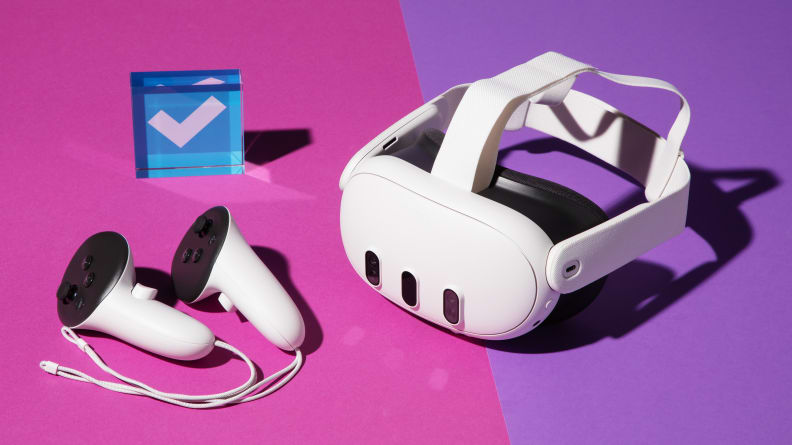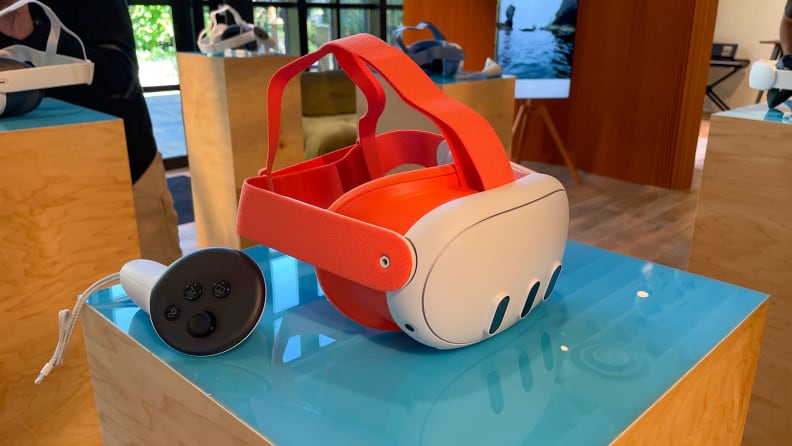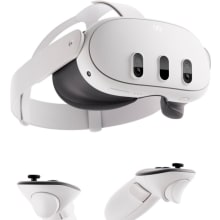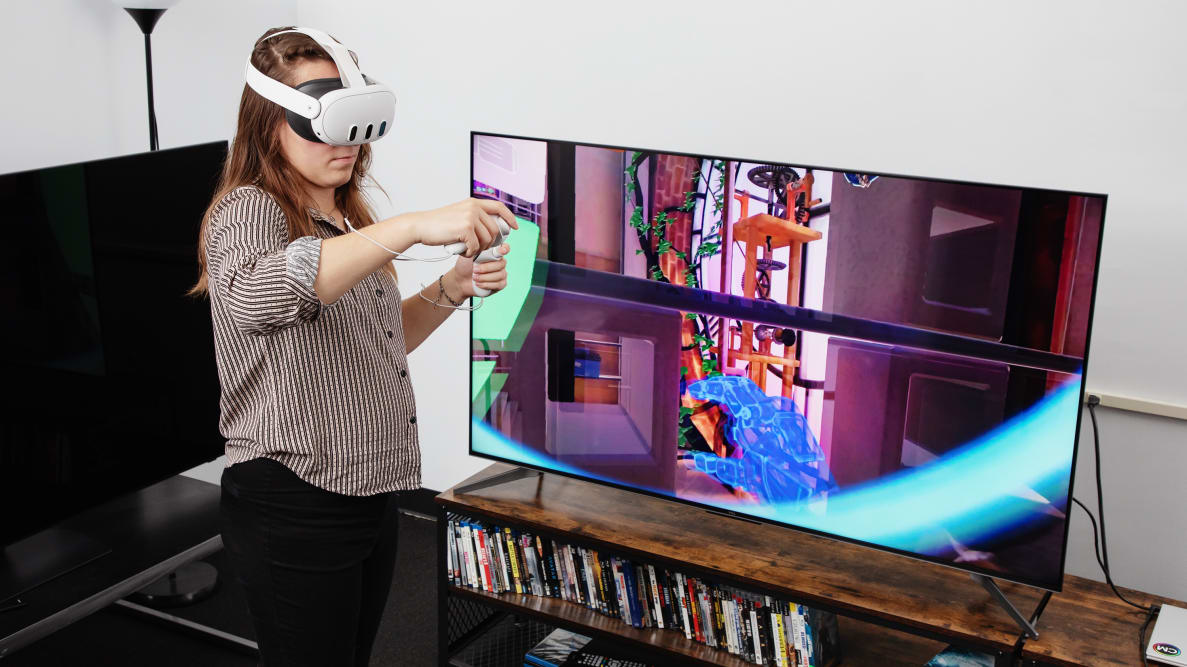Pros
-
Improved specs and screens
-
Comfortable and easy to fit out of the box
-
Mixed reality is genuinely impressive
Cons
-
Stock strap won’t fit everyone
-
VR games can still be nauseating
-
1.5-3 hour battery life
About the Meta Quest 3
The Meta Quest 3 comes with two included Touch Plus controllers (each powered by a AA battery), as well as an 18-watt USB-C charger. That’s it; Meta offers a $130 charging dock with rechargeable batteries for the controllers, as well as a $70 carrying case and a $70 Elite Strap that the company claims is more comfortable and durable than the stock offering and can be configured with an extra battery, but all are sold separately.

Meta has ditched the big plastic rings for the latest iteration of controllers.
Meta Quest 3 Specs
- Price: $500 for the 128GB model; $650 for 512GB
- Weight: 515 grams (18.1 ounces)
- Tracking: Six degrees of tracking; six embedded cameras for simultaneous localization and mapping (SLAM) tracking
- Storage: 128 GB or 512GB
- Display: 90Hz LCD display with 2064 x 2208 pixels per eye (120Hz experimental mode)
- Processor: Snapdragon XR2 Gen 2
- RAM: 8GB
- Connectivity: Wi-Fi 6E, Bluetooth 5.3
- Battery life: 1.5-to-3 hours under normal use
The Quest 3 offers a slew of incremental upgrades over the Meta Quest 2 other than the design refresh. RAM has been bumped up from 6GB to 8GB, the field of view is 15% wider at 110 degrees horizontal and 96 degrees vertical, and Meta claims the second-generation Snapdragon XR2 processor inside is twice as performant graphics-wise as the Quest 2. Meta claims the integrated speakers are 40% louder with more bass, the resolution of the lenses is 30% greater, and the headset now boasts six color cameras for pass-through mixed-reality video.
The Quest 3 borrows the same pass-through technology as the more expensive Quest Pro (and Meta claims the image quality is actually higher on the Quest 3), but lacks the Pro’s eye-tracking technology. That means the Quest 3 can’t do foveated rendering, or dedicate more processing power to better render what the user is looking at while dropping the quality of elements outside of the line-of-sight, a trick the $550 PlayStation VR2 includes.
What we like
Plenty of built-in adjustability

Meta sells Elemental Blue and Blood Orange straps for an additional $50.
Meta clearly listened to the feedback folks had about the Meta Quest 2. A Facebook account is no longer required to use the Quest 3 (only a separate Meta account), but there are larger ergonomic improvements built into the headset itself.
The front of the headset now features a wheel for adjusting the interpupillary distance (IPD) between lenses in one-millimeter increments, from 53mm to 75mm; the Quest 2 only had three IPD settings of Narrow, Middle, and Widest. You can also click the buttons on the sides of the facial interface’s interior—the part that connects to the headset and blocks out light—to slide it forward or back, allowing for enough room to accommodate a pair of glasses.
The included Y-shaped strap also distributes weight better. While the Meta Quest 3 is 12 grams heavier than the Quest 2, the redesigned strap does a great job of distributing weight. It’s also easy to adjust; pull the two bands at the back apart to tighten, and push them together to loosen it. Then, you can pull the Velcro top strap tight to ensure a comfortable seal.
In practice, I was able to get a tight, comfortable seal that blocked out all light and that didn’t feel constricting or heavy. The headset didn’t move around at all when I was bopping along to the rhythm in games like Samba de Amigo or Beat Saber, and felt comfortable enough that I was able to watch a movie while wearing it.
Mixed reality works well

A slew of productivity apps are available for download on Meta Quest devices, not just games.
The biggest improvement the Meta Quest 3 brings to the table over its predecessor is the addition of full-color, high-resolution pass-through video thanks to the six cameras on the headset (four on the front and one on each corner of the underside).
Meta is clearly trying to beat the $3,500 Apple Vision Pro to market as a mixed reality headset for both gaming and serious work (though it lacks a fishbowl-style front bubble display to show your eyes). Is the pass-through video on the Quest 3 good enough that you might forget you’re wearing it? Not really.
At a glance, the video feed on the headset is crisp and seemingly accurate, but not enough to resolve finer details at say, smaller than a quarter-of-an-inch. I could read text on my monitors and phone if I squinted but there’s no mistaking what you see for unfiltered real life. Still, that’s impressive. If your goal is to watch a movie or browse the web on a giant, 96-inch screen in your living room somewhat convincingly, the Quest 3 can do it, and well enough that you might feel comfortable saving $3,000.
Even more impressive is the room mapping and persistent virtual widgets the Quest 3 brings to the table. Instead of having to lay down markers or base stations like the Valve Index to map out the boundaries of your play space, the walls, ceiling, floor, and furniture can be mapped automatically or set up manually to create a persistent virtual room.
The end result works surprisingly well; I plopped a floating window in the middle of my living room, then couldn’t immediately find it the next time I put the headset on. It turns out I had left it hovering over the couch. The same holds true for VR play boundaries, as they will remain in the same spot between sessions. Eventually, Meta wants to integrate persistent virtual widgets or portals to apps that will live in your room, but I wasn’t able to test that feature at the time of writing.
The controllers aren’t needed, either, which is a nice touch. If you just want to chill out and casually use the Quest 3, the hand tracking works well enough that you can navigate just fine.
Content looks fantastic

The Meta Quest 3 can cast to a TV or compatible streaming device.
Gone are the days when VR headsets were plagued by the screen door effect, a low resolution that made individual pixels obnoxiously noticeable. The improved resolution on the Meta Quest 3 means that videos, photos, and text uniformly look good, and at the scale VR deals with, quite lifelike.
Being able to sit in a virtual theater and watch content on a giant screen is a tried-and-true VR trick at this point, and as the screens on those headsets improve, so will the experience here. I watched an episode of Twin Peaks, and rewatched both Spider-Man: Across the Spider-Verse (a movie I’ve seen in a real theater and on my LG C2) and The Venture Brothers: Radiant Is the Blood of the Baboon Heart via Amazon’s VR Prime app and had a great time. Color accuracy, contrast, and motion clarity are all quite good on the Quest 3, and the theater effect is especially convincing thanks to the expanded field of view.
Since Meta unfortunately didn’t opt for OLED screens with the Quest 3, there’s some backlight bloom in black scenes, making that dark theater slightly more gray than realistically black. The headset also doesn’t have HDR, but that isn’t too surprising as even the best gaming monitors at $500 or less lack that capability.
Although Meta didn’t provide a Link Cable with our review unit, I was able to connect my PC just fine over my home Wi-Fi network using their Oculus software. Browsing the web, reading text, and even playing slower-paced games that only need the Touch Plus controllers, like Hearthstone, was easy to do, looked crisp, and was as legible as the native monitors I was mirroring.
The ability to pull up both monitor displays and have them float in front of your face, and make them as large or small as you want, feels immersive and bodes well for a future where you can work from a VR headset if you so choose. The ability to float those displays in mixed reality rather than inside of a featureless void (within a bounded play space) would go a long way towards making this a feature to mix into an everyday productivity routine, but isn’t possible at the time of writing.
Meta also improved the built-in sound quality. After watching movies and playing games on the Quest 3, I’d put it at about the same level of sound quality as my second-generation Apple AirPods. Listening to music won’t blow your mind, but it’s good enough for most people and puts out enough bass to be noticeable. Meta has also included a 3.5mm jack on the side of the headset if you want to plug in your own headphones.
Gaming is better than ever
I’m not sure if the new Snapdragon XR2 Gen 2 processor inside the Quest 3 is twice as performant as its predecessor, but native gaming on the headset looks noticeably nicer. I’d peg the graphical fidelity of the newer Quest 3 games I was given to test out at about the level of the Nintendo Switch. That might not sound impressive, but remember that each screen is 2064 x 2208 pixels, and the Quest 3 is rendering each image twice at 120Hz.
As much as Meta is pushing VR as the next frontier for productivity, the Quest 3’s mainstream appeal will live and die on the strength of its games. I wasn’t able to test Asgard’s Wrath 2, the flagship title Meta is bundling with the Quest 3 (it comes out December 15), but the games I did have access to ranged from “fun” to “fine.”
The biggest winners are VR games where you don’t risk getting motion sick. The Meta Quest versions of Samba de Amigo and Beatsaber remain great, even if they’re ports of fantastic rhythm games you can already play on myriad other platforms. The few mixed-reality games I tried worked really well, even if they’re few in number right now (though I’m sure that will change). I didn’t get the opportunity to test Quest ports of larger games like PowerWash Simulator, but it’s heartening to see that they exist, are still supported, and will play better than ever on the improved hardware.
Other titles were more of a mixed bag. Islanders: VR, a port of a cute little puzzle game where you score points by placing buildings down on an island, runs just fine but is a little unwieldy to navigate, even if the new Touch Plus controllers are well-balanced and comfortable to use. Meta included a full copy of Red Matter 2, a sci-fi puzzle exploration game, and the visuals hewed closer to the Steam version than what the Quest 2 outputs. Running a game like that, with detailed items and full physics (so you can toss things around), is exciting, but I wound up getting motion-sick and having to quit.
And, while I wasn’t able to test PC gaming at full bandwidth, I didn’t have a problem with playing wirelessly over Air Link or getting Steam VR to run. Though it will be a bit more work to get it set up, I expect the Quest 3 will prove an attractive headset for PC gaming, especially when the Valve Index costs twice as much. According to the Steam hardware survey put out just before the Quest 3’s release, the Meta Quest 2 accounts for 41% of VR headsets used on the platform versus only 19% for the Index, so the precedent already exists.
Finally, for those worried about whether the Quest 3 will have the gaming juice in the long term, all of the Meta Quest 2 games are backwards compatible and it’s expected that Quest 3 games will remain similarly playable on the older platform. Meta is also integrating Xbox Cloud Gaming sometime down the line, but I didn’t get a chance to test it.
What we don’t like
Nailing a fit isn’t perfect

The Quest 3 requires regular cleaning. We found that even the internal screens can get smudged when putting the headset on.
Although Meta has radically expanded the integrated comfort and adjustability options with the Quest 3, it still isn’t perfect.
Yes, the headset can be used with your glasses on, meaning you don’t need to play blind or order pricey custom prescription inserts like you did with the Meta Quest 2. In practice, even with the facial interface at its maximum extended distance, I couldn’t stand the feeling of my glasses jostling against the internal screens and ended up playing without them (thankfully my vision is good enough to make it work).
It’s a different story if you have a lot of hair. My girlfriend wears glasses and has natural hair, and she wasn’t able to get a comfortable fit. The stock Y-shaped headband wasn’t touching her head even when fully extended, and I worried the headset might jostle off during high-intensity games. The Elite Strap might solve this problem but it wasn’t provided for reviewers to test.
I also noticed a thick ring of sweat along where my nose sat every time I took off the headset even after only moderate use. The soft-touch plastic your face rests against isn’t breathable, so it needs to be kept clean. I have sensitive skin and wouldn’t be surprised if I ended up breaking out after using the Meta Quest 3 regularly. That’s unfortunate, as Meta is positioning the Quest 3 as a home workout tool—I can’t imagine how gross the inside of the headset would get if you forget to wipe it down regularly.
VR can still be nauseating
When I first went hands-on with the Meta Quest 3 at a reveal event in September, I had to tap out after getting motion sick during the Assassin’s Creed Nexus demo. I thought that, after enjoying the mixed reality games, I just needed more time to adjust to fully immersive VR scenarios where you move around with the thumbsticks. I was wrong.
Meta provided multiple fully immersive VR games to try out on the Quest 3, and I couldn’t really get into any of them. Red Matter 2, Assassin’s Creed Nexus, and Dungeons of Eternity all made me feel ill after a few minutes of walking around, and that extended to my experience with Hellblade: Senua's Sacrifice, one of the few VR games I own on Steam, even though I was seated. I didn’t have any problem with playing non-VR games in Steam’s theater mode, but if you’re particularly sensitive to motion sickness, you might want to avoid games like this.
Should you buy the Meta Quest 3?
Yes, it’s the best all-around VR headset available

The Meta Quest 3 can map walls, ceilings, and floors to create a persistent virtual play space without much work required.
Even if you’re a VR skeptic like myself, it’s hard to argue that the Meta Quest 3 isn’t currently the best VR headset on the market right now. The PlayStation VR2 technically wins out display-wise, but since it’s tethered to the PS5, it really isn’t something for day-to-day use.
If you’re looking for a VR headset for watching movies, browsing the web, and then gaming on after work is done, the Quest 3 really can do it all. It’s an incremental upgrade over the Meta Quest 2 for sure, but the improvements are noticeable to even a journeyman VR goer. The Quest 2 remains an excellent entry point into the market at $299, but I would spend the extra $200, even if just for the small quality-of-life upgrades like the improved controllers.

The Meta Quest 3 delivers higher-resolution screens and full-color, pass-through video.
Meet the tester
Jonathan is an Electronics Editor for Reviewed specializing in gaming gear and has experience with everything from controllers to benchmarking the latest GPUs. He was previously the Web Editor at The Architect's Newspaper.
Checking our work.
Our team is here to help you buy the best stuff and love what you own. Our writers, editors, and experts obsess over the products we cover to make sure you're confident and satisfied. Have a different opinion about something we recommend? Email us and we'll compare notes.
Shoot us an email




